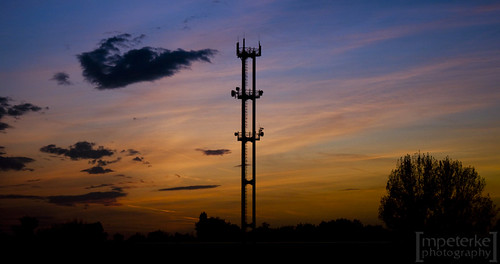
Photo: Peter Megyeri
The radio is a perfect example of an old technology that we completely take for granted – do you know how it works or are you just cluelessly upset when all you hear is static? These older technologies are much easier to wrap my head around – if a some guy in the 19th century could figure it out, I should be able to understand the basic idea. I’m not going to focus on how a radio transmitter physically creates the signal or receiver is able to turn it into sound, but rather the basic theory and some interesting things to know.
What is the major difference between AM and FM?
AM stands for amplitude modulation. This means the sound determines the amplitude of the radio wave. FM stands for frequency modulation – the sound alters the frequency of the radio wave. The transmitter is able to turn the sound being created into the appropriate wave. Here is an example of a sound and how it would look as an AM and FM wave:

Source: Berserkerus
Another major difference is that AM radio waves are a much lower frequency than FM. Think of AM having the wavelength of a football field and FM the ball. In reality you can broadcast amplitude modulation or frequency modulation at any frequency, but high quality FM audio must be a high frequency to allow for the differences (or modulation) in frequency.
Wait a minute …
As you may know, when you change the dial on your car radio you are actually telling it what frequency to listen to. For FM this confused me – I am telling it an FM frequency to listen to, but the received frequency keeps changing depending upon the sound that is being transmitted. In this case you are letting the receiver know a base frequency to listen to, but it still picks up signals that are close in frequency. It is able to determine the sound by how far the received frequency is from the base frequency.
Let’s start with AM
I thought that AM was just an older, cheaper technology and that FM was superior in every way. Boy was I wrong.
One advantage of a lower frequency (AM) is that it decays much slower – meaning it travels farther through objects (including air) before dying out. You have probably noticed bass thumping through walls (in the club) much better than an equally loud shrill yell.
But the real advantage of using a lower frequency is the natural behavior of the wave. At a low frequency the radio wave actually clings to the semi-conductive surface of the earth. Furthermore, the waves that are propagated upwards into the atmosphere are often reflected off the ionsphere and back to earth.
Why is FM so popular then?
Frequency modulation is the favored way of transmitting audio for a number of reasons. First, you are able to create a much wider range of sounds with FM. More importantly – if you have a car radio you probably have noticed this – less static!
AM waves become jacked up when around another source of radio emission at the same frequency – this can be anything from lights, power lines, or even car engines. The radio wave you are attempting to listen to combines its amplitude with the “noise” to create a very different sound. FM receivers do not care about the incoming wave’s amplitude, only its frequency, so these additional sources of radio emission do not create static over your music.
But high frequency waves (FM) do not propagate the same way as low frequency (AM). FM waves behavior is similar to light – it does not cling to the surface of the earth or bounce off of the atmosphere. They call this line of sight.
What does this have to do with Lady Gaga?
Because FM radio is line of sight it only travels roughly 50 miles along the ground before the curvature of the earth causes issues. Operating under the assumption that your car’s antenna is not 200 feet tall, FM radio stations build tall towers or broadcast from on top of a mountain in an attempt to reach more people. FM generally also use more power to blast the decaying signal through mountains or other objects on the way to your receiver. Further, if broadcasting music, the higher fidelity of FM is in high demand so the station will have to pay more for the rights to use the frequency (there are only so many frequencies available for a given area).
These all add up to being more expensive – if you want to broadcast in FM over a given area it is going to cost more than for AM. Thus, FM radio stations are primarily hip new music like Lady Gaga with a lot of people to listen to the advertisements. AM is cheaper per mile covered and features great entertainers such as Merle Haggard!
What else is cool?
The ionsphere reflection of AM radio waves is significantly more effective at night. Try scanning your AM radio for stations during the day compared to at night – you will receive more stations at night and they will come through clearer! Due to this phenomenon radio stations in the US are forced to reduce their transmission power at night.
During the early 20th century some AM radio stations were broadcast with 10 times the power used today. Some of these stations were rumored to be heard worldwide. (I couldn’t find a good source for this, so if you know where to look or have super-human Google skills I’d be interested.)
Sources:

Wikipedia to the rescue? I didn’t check their references.
“American AM radio stations broadcast with powers as high as 500 kW, and some could be heard worldwide”
Somewhat related? http://www.rowetel.com/blog/?p=118
I saw that on Wikipedia, but it didn’t have a reference associated with it – how can someone put that in the article without providing a reference? It sure doesn’t sound like common knowledge to me …